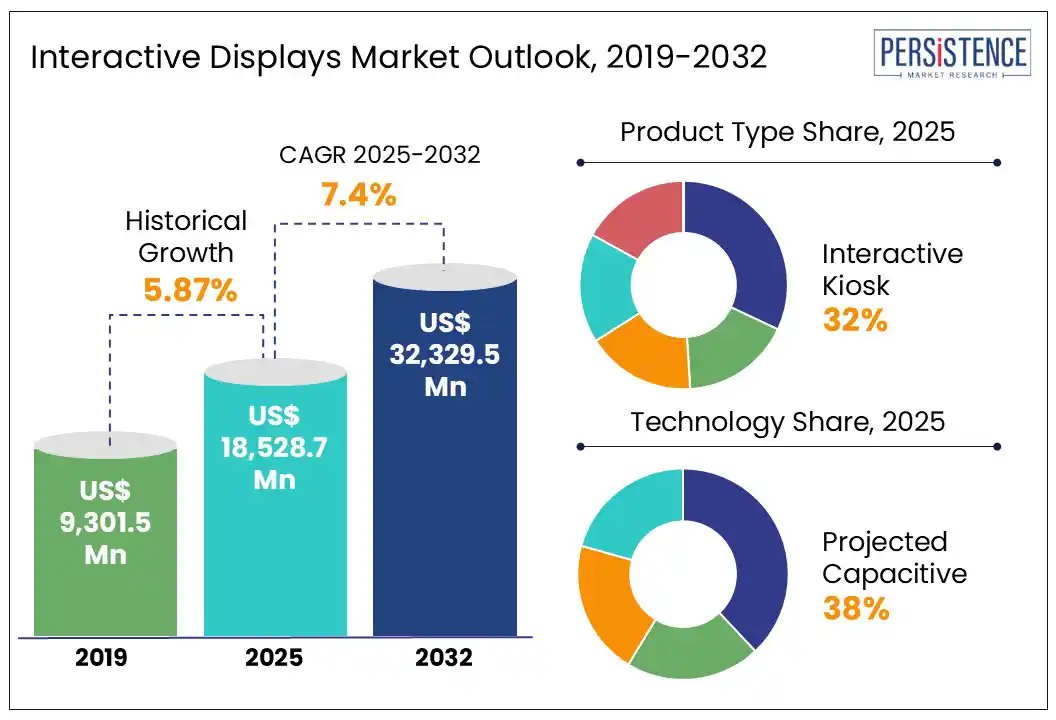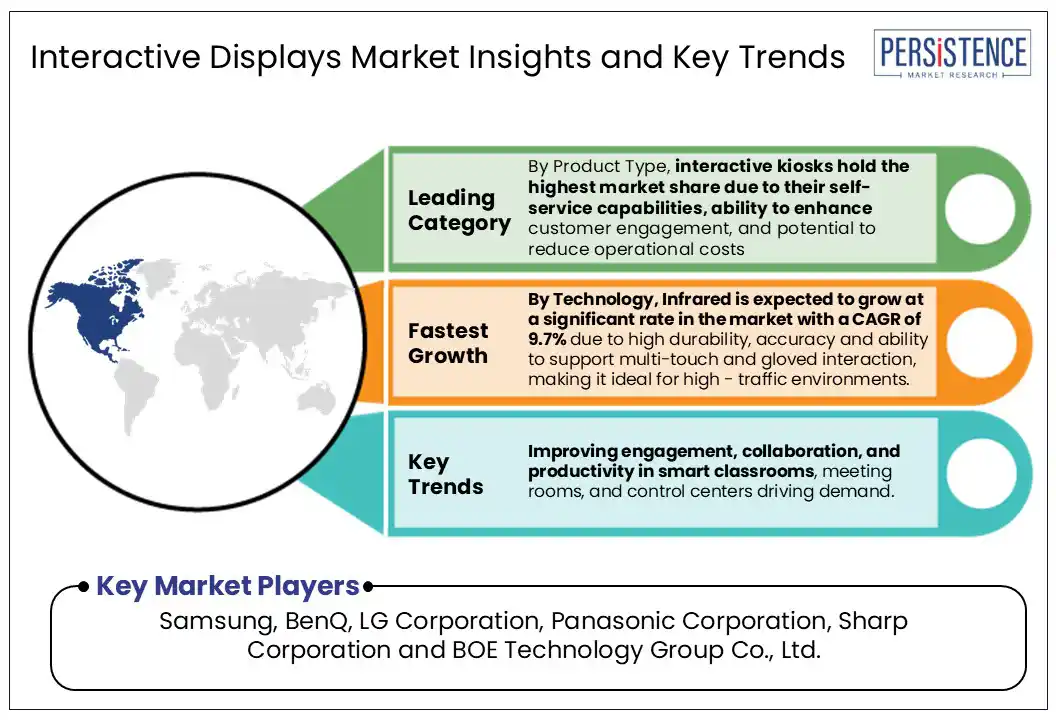ID: PMRREP5738| 184 Pages | 18 Jul 2025 | Format: PDF, Excel, PPT* | Semiconductor Electronics

The global interactive display market size is likely to be valued at US$ 18,528.7 Mn in 2025 to US$ 32,329.5 Mn by 2032, growing at a CAGR of 7.4% during the forecast period from 2025 - 2032.
Interactive displays, which are also known as interactive flat panel displays (IFPDs), are touchscreen-enabled devices that increase collaboration and engagement through gestures, touch, or other input devices such as voice and motion. The shift toward digital learning and smart classrooms is boosting demand. The proliferation of smart devices, declining display panel prices, improvements in touchscreen sensitivity and resolution, and the growing emphasis on user-friendly, energy-efficient, and cloud-compatible solutions.

Key Industry Highlights
|
Global Market Attribute |
Key Insights |
|
Interactive Displays Market Size (2025E) |
US$ 18,528.7 Mn |
|
Market Value Forecast (2032F) |
US$ 32,329.5 Mn |
|
Projected Growth (CAGR 2025 to 2032) |
7.4% |
|
Historical Market Growth (CAGR 2019 to 2024) |
5.8% |
The emphasis on dynamic, participatory, and collaborative environments across education, corporate, and public sectors is driving demand for interactive display technologies. These solutions enable real-time interaction, enhance group collaboration, and streamline communication through features such as touch input and gesture recognition. In education, interactive whiteboards and kiosks are replacing traditional methods, with companies like SMART Technologies offering intuitive, purpose-built tools such as the SMART IQ with the MX series. These displays help educators save time and deliver more engaging, impactful learning experiences.
Similarly, in corporate sectors, interactive whiteboards and digital signage are improving meetings, presentations, and collaboration among teams. For instance, BenQ’s Corporate Interactive Displays, including the BenQ Board Pro series, support features such as wireless screen sharing, multi-window mode, and seamless integration with video conferencing platforms such as Zoom, Microsoft Teams, and Google Meet. The rise of large-scale interactive video walls for conferences, events, and training sessions further underscores the corporate sector’s shift towards digitized, real-time communication.
Interactive displays often collect a range of information, from basic user inputs and behavioral data to more sensitive details such as facial recognition. This raises issues around data privacy, especially under stringent regulations such as GDPR and CCPA. In sectors such as schools and hospitals, where strict compliance is mandatory, fears of data breaches or unintentional data exposure can hamper adoption and raise resistance in the market.
The growing integration of these displays with IoT devices and cloud-based platforms introduces serious cybersecurity vulnerabilities. These systems can become targets for hackers aiming to inject malware, alter content, or gain access to internal networks. High-profile cases where public displays were hacked to show inappropriate or misleading content have resulted in reputational damage and legal repercussions for the affected organizations. For instance, a case reported by Wired highlighted how DTEN smart touchscreen displays used in virtual meetings had critical flaws, such as unencrypted data storage and insecure debug settings, which allowed unauthorized access and potential eavesdropping. Such incidents further heighten institutional caution and act as a barrier to broader deployment.
Integration of AI enables displays to become more intuitive, adaptive, and responsive to user behavior, creating personalized and intelligent user experiences across sectors. In education, AI-powered displays analyze student engagement and learning patterns in real time, enabling teachers to tailor instruction accordingly. For instance, in January 2025, Samsung Electronics launched its new AI-powered Interactive Display (WAFX-P Model). Leveraging Samsung AI Assistant, the education-focused display combined advanced hardware and advanced AI capabilities to create smarter learning environments that are more engaging and collaborative.
In retail, these displays enable dynamic customer experiences by analyzing consumer behavior, preferences, and demographics to deliver targeted advertisements or product recommendations, thereby increasing sales and customer satisfaction. For instance, LG's MAGNIT Boxed Set Display incorporates AI-enhanced processing to deliver high-quality visuals for corporate environments. Features such as screen sharing and Office Meeting Mode facilitate seamless presentations and collaborations. These innovations are not only enhancing user engagement and collaboration but also streamlining operations and improving accessibility.
The touch-enabled displays are being integrated throughout hospitals and clinics to provide real-time access to digital records, facilitate streamlined communication among care teams, and enhance the overall patient experience. By enabling instant updates and interactive content sharing, these displays help reduce delays in decision-making, support faster diagnostics, and empower patients to be more actively involved in their treatment journey. For instance, approximately 70% of hospitals in the U.S. have adopted digital communication systems, indicating widespread adoption of digital signage technology in healthcare settings. These systems leverage technology to enhance patient care, improve communication, and streamline operations.
Leading technology providers are also shaping this transformation. For instance, Samsung’s line of healthcare-focused displays is designed to enrich patient interactions at every touchpoint of a hospital visit. These displays feature integrated Wi-Fi, modular touch overlays, and embedded media players that support seamless content mirroring. This allows hospitals to deliver personalized information directly to patient rooms, such as care instructions, medication schedules, or entertainment, thus improving comfort and understanding while reducing reliance on staff for routine updates. Beyond patient-facing uses, interactive displays are revolutionizing clinical collaboration, allowing medical professionals to annotate images, review scans in real time, and conduct remote consultations with specialists, bridging gaps across departments and even geographic locations.
Based on product type, the market is divided into interactive kiosk & digital signage, interactive whiteboard, interactive tables, interactive video walls, and interactive touch monitors. Among these, interactive kiosks are expected to lead the market with over 32.4% due to their increasing use in retail, hospitality, transportation, and healthcare for self-service, wayfinding, and customer interaction. Interactive kiosks offer a user-friendly, engaging experience that helps businesses enhance customer engagement and improve service delivery.
Interactive digital signage is also expected to experience significant growth, fueled by the rising demand for advertising and information display in public spaces. Digital signage allows businesses to communicate with consumers in real-time and create dynamic, personalized content.
Based on technology, the market is segmented into infrared, projected capacitive, resistive, and optical imaging. Among these, projected capacitive touch technology is expected to lead the market share with more than 38% due to its superior touch sensitivity, durability, and multi-touch capabilities. It also offers better clarity and response time compared to other technologies. The widespread adoption of smartphones and tablets further supports its integration into large-format interactive displays. Its sleek design and low maintenance contribute to its rising preference across sectors.
Infrared touch technology is becoming increasingly popular for its adaptability in large-screen formats, especially in applications like interactive video walls and digital signage. This technology allows for seamless, touch-sensitive surfaces without the need for a physical layer over the screen. Resistive touch technology, though not as advanced as projected capacitive, continues to serve cost-effective solutions for various interactive applications, particularly in environments where durability is essential.

North America is expected to account for more than 36% of the interactive display market in 2025, with the U.S. leading the region due to strong investments in educational technology and enterprise collaboration tools. By 2023, over 60% of classrooms in the U.S. had at least one interactive display system installed, reflecting widespread adoption in the education sector.
The release of the 2024 National Educational Technology Plan (NETP) by the U.S. Department of Education has also played a role, emphasizing the importance of addressing digital inequities in access, design, and usage. Complementary initiatives such as the Digital Equity Act and various state-led programs continue to advance digital literacy and ensure broader access to modern educational tools for students and teachers alike.
In Canada, growth is also evident, particularly within the healthcare sector, where interactive monitors are being introduced in patient care rooms, nurse stations, and information kiosks in hospitals. These installations are aligned with Canada’s broader digital transformation mandates in public health services, aiming to improve patient engagement and streamline administrative functions.
In China, the government's focus on smart city development and AI integration has significantly accelerated the deployment of interactive kiosks and digital signage in public areas and transportation hubs. Reflecting the impact of these efforts, China’s position in the Global Digital Education Development Index rose from 24th to 9th in 2025, following the implementation of nationwide smart teaching policies. Japan, known for its technology-driven infrastructure, maintains a steady demand for interactive displays in corporate boardrooms and public services.
India is emerging as a high-growth market, propelled by the Digital India initiative, the rise of edtech platforms, and an increasing shift toward hybrid work models. Affordable internet access, growing device penetration, and strategic investments by education technology firms are extending the reach of interactive displays into Tier 2 and Tier 3 cities. For instance, as reported by the Economic Times, the Delhi government has announced plans to develop over 2,000 digital classrooms equipped with 75-inch or larger interactive display panels, personal computers, and Wi-Fi routers for students in Classes 6 to 12, with an estimated investment exceeding ?65 crore.
Strong policy support and strategic initiatives are driving growth across Europe, with a clear focus on accelerating digital transformation in various sectors. Several countries are actively investing in technology infrastructure to enhance their digital capabilities and competitiveness. For instance, Germany has made significant investments, allocating US$5.9 billion till 2030 under its Digital Pact 2.0 to support the digitalization of schools. The corporate sector is also upgrading meeting rooms with smartboards and large-format displays to enhance team collaboration.
In U.K., the adoption of interactive flat panels in the workplace is growing steadily, supported by hybrid work policies and an increasing number of video-conferencing setups. France and Italy have shown increased interest in leveraging interactive technologies in both the retail and education sectors. Retailers are deploying digital kiosks and interactive signage to personalize customer experiences, while schools and training centers are integrating interactive displays into learning modules to enhance engagement.
The global interactive displays market is fragmented, featuring a diverse mix of established technology giants and specialized players. Leading global brands such as Samsung Electronics, LG Electronics, and Sharp Corporation hold a strong position in the market, leveraging their extensive product portfolios, global reach, and technological expertise. They are investing in research and development (R&D) to incorporate advanced technologies such as artificial intelligence, gesture recognition, and multi-user support into their offerings.
The global market is projected to be valued at US$18,528.7 Mn in 2025.
Improving engagement, collaboration, and productivity in smart classrooms, meeting rooms, and control centers is the key market driver.
The interactive display market is poised to witness a CAGR of 7.4% from 2025 to 2032.
The rising popularity of AI and IoT for analytics, personalization, and automation creates key market opportunities.
LG Corporation, Panasonic Corporation, Sharp Corporation and BOE Technology Group Co., Ltd. are among the leading key players.
|
Report Attribute |
Details |
|
Historical Data/Actuals |
2019 - 2024 |
|
Forecast Period |
2025 - 2032 |
|
Market Analysis Units |
Value: US$ Bn/Mn, Volume: As Applicable |
|
Geographical Coverage |
|
|
Segmental Coverage |
|
|
Competitive Analysis |
|
|
Report Highlights |
|
|
Customization and Pricing |
Available upon request |
By Product Type
By Technology
By Panel Size
By Application
By Region
Delivery Timelines
For more information on this report and its delivery timelines please get in touch with our sales team.
About Author